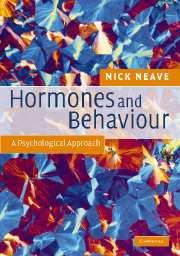Book contents
- Frontmatter
- Contents
- List of diagrams
- Preface
- Acknowledgements
- 1 Background to psychobiology
- 2 Hormones and the endocrine system
- 3 Behavioural endocrinology
- 4 Neurological effects of hormones
- 5 Typical sexual determination/differentiation
- 6 Atypical sexual differentiation
- 7 Neural differentiation
- 8 Reproductive/sexual behaviours
- 9 Attachment/parental behaviours
- 10 Aggressive/competitive behaviours
- 11 Sex steroids and cognition
- References
- Index
5 - Typical sexual determination/differentiation
Published online by Cambridge University Press: 05 June 2012
- Frontmatter
- Contents
- List of diagrams
- Preface
- Acknowledgements
- 1 Background to psychobiology
- 2 Hormones and the endocrine system
- 3 Behavioural endocrinology
- 4 Neurological effects of hormones
- 5 Typical sexual determination/differentiation
- 6 Atypical sexual differentiation
- 7 Neural differentiation
- 8 Reproductive/sexual behaviours
- 9 Attachment/parental behaviours
- 10 Aggressive/competitive behaviours
- 11 Sex steroids and cognition
- References
- Index
Summary
The initial question that nervous parents ask when they attend their first routine scan during pregnancy is usually ‘is it a boy or a girl?’ We attribute major significance to the sex of our offspring, and throughout their lives these males and females will forever be labelled accordingly, and provided with numerous ‘rules’ from various societal, legal and religious sources, that will govern their interactions with one another. It is not surprising then that one of the key questions that has enthralled behavioural endocrinologists and social scientists, in almost equal amounts, concerns that of sexual determination/differentiation – how genes initially determine sex, and then how a variety of factors (principally hormonal) cause the sexes to differentiate in terms of their morphology, physiology and, most controversially perhaps, behaviour and psychology. From a psychological perspective, the study of such sexual differentiation in relation to cognition, personality, mood, etc. has formed major research topics that even now are dogged by controversy, hyperbole and downright sensationalism.
Feelings always run high when the topic of sex differences rears its head. I write this shortly after the resignation of Harvard president Lawrence Summers, for, amongst other things, suggesting that females were biologically less predisposed than males to succeed in mathematics/science. In fact it is only fairly recently that one could even use the term ‘sex’ in the context of such differences, the word ‘gender’ being the more ‘politically correct’ term (many psychologists in fact confuse the two and don't appear to understand the difference between them!).
- Type
- Chapter
- Information
- Hormones and BehaviourA Psychological Approach, pp. 85 - 108Publisher: Cambridge University PressPrint publication year: 2007

